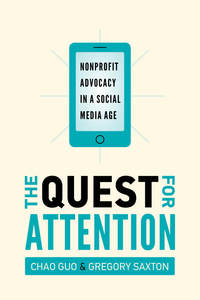The past year and a half I’ve been working on an academic book for Stanford University Press with my friend Chao Guo, Associate Professor of Nonprofit Management in the School of Social Policy & Practice at the University of Pennsylvania. We’re happy to say, the book is out!
 |
Guo, Chao, & Saxton, Gregory D. (2020). Quest for Attention: Nonprofit Advocacy in a Social Media Age. Stanford, CA: Stanford University Press. |
The book is a culmination of the work Chao and I have done that draws on our understanding of nonprofit organizations, advocacy efforts, and data analytics. Here’s a brief description of the book:
Today, social media offers an alternative broadcast and communication medium for nonprofit advocacy organizations. At the same time, social media ushers in a “noisy” information era that renders it more difficult for nonprofits to make their voices heard. This book seeks to unpack the prevalence, mechanisms, and ramifications of a new model for nonprofit advocacy in a social media age. The keyword for this new model is attention. Advocacy always starts with attention: when an organization speaks out on a cause, it must ensure that it has an audience and that its voice is heard by that audience; it must ensure that current and potential supporters are paying attention to what it has to say before expecting more tangible outcomes. Yet the organization must also ensure that advocacy does not end with attention: attention should serve as a springboard to something greater. We elaborate how attention fits into contemporary organizations’ advocacy work and explain the key features of social media that are driving the quest for attention. Developing conceptual models, we explain why some organizations and messages gain attention while others do not. Lastly, the book explores how organizations are weaving together online and offline efforts to deliver strategic advocacy outcomes.
We hope you like it! If you’re interested in buying your own copy, or requesting a review/desk/examination copy for your course, please visit the Stanford University Press site or Amazon.com.
On this page I will be placing tutorials, additional analyses, and replication code related to the book.
Please check back again soon!
